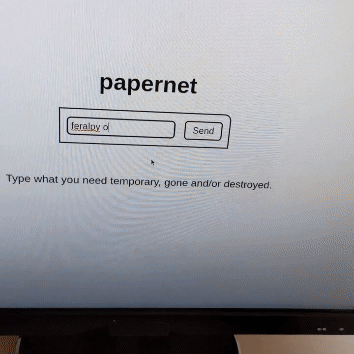Papernet [Live Web]
Papernet #

Final project for Live Web. A small network between users around the world and a single thermal printer in NYC. Users sent text messages directly to the printer via a self-hosted https webpage on a Raspberry Pi 3 Model B. Printed messages were then immediatley shredded by a mechanical paper shredder a few inches below.
My Process #
May:
1) checkout a TTL adafruit thermal printer
2) test printing from an arduino uno
3) source a small mechanical paper shredder
4) attempt to attach a 360 degree servo (powered by arduino uno) to mechanical paper shredder (fail for now)
5) pivot thermal printing and socket recieving to raspberry pi instead of arduino
6) checkout a netgear nitehawk router
7) set up port forwarding on 443 (https)
8) get a domain name and ssl from namecheap (ty github for students)
9) ask gpt to make a quick front end page with html and css for user input
10) write node.js server to recieve socket data from front end and end to printer over RX + TX 11) share the url and get to manual shredding\
June: 1) Order an electric (battery powered) mini paper shredder & thermal printer
2) Consult Mat Olsen about wooden enclosure + Mat builds enclosure from single plank of natural wood binded with wood glue and screws and stabilized by plywood base (all found materials)
3) Secure printer & shredder to enclosure first with industrial grade velcro (supposedly) later with hot glue. 4) Cable management + pi securing with zipties
Next Steps #
- Build a standalone wood unit to hold the printer above the shredder and servo in place to control the shredder
- Integrate some sort of sensor or timing system to make the servo turn on only when text has recently been printed
- Short-Term: set up the printer in my house and live stream it on the front end page.
- Long-Term: find a permanent home to host papernet (and pay for it’s internet bandwidth lol) in the public eye (ideally a small window like display) where people can only read the text output in person for a short time. Recording of the network would be discouraged through lighting design and sinage.
Summary of technologies used: #
- Adafruit Thermal Printer TTL connection
- Netgear Nitehawk router
- Raspberry Pi 3 Model B
- University enterprise network
- Socket.io
- Node.js
- Html, CSS